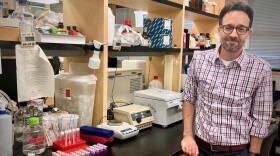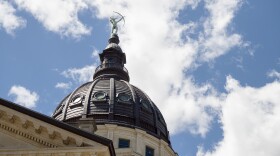But according to tribal citizens, that ‘Indian’ was never killed.
As part of a collaboration with NPR and non-profit Cortico, KOSU held community conversations with Indigenous groups across the state and asked: where do you find common ground?
The answer? Resiliency.
Scars from the past
Four elder docents, each with a unique story, sit around a table at the First Americans Museum in Oklahoma City. Among them is Sac and Fox citizen Harold Meek, a survivor of the boarding school era.
“I was six years old,” he said. “I remember going to the Oklahoma City bus station — it was my first time riding a Greyhound bus.”
That bus would take him to El Reno, where he was placed in the Concho Indian Boarding School.
“I was scared. I didn't know anybody then at that time…It was new to me,” he said. “They cut my hair, they gave us showers, and they washed our clothes and gave them back to us and fed us and went to bed.”
Meek’s experience at Concho would include abuse at the hands of adults and his peers. The aftermath of his childhood would accumulate into anger and resentment as he grew older and negatively affect his life.
“I’ve had to work through my traumas and through my alcoholism and my abuse that was introduced to me at a very young age because that really impacted my life,” he said. “I've gone through different relationships and marriages, I didn’t have the skills to handle my emotions.”
It’s a story that’s not unusual in Oklahoma. Home to 39 tribal nations, Indigenous families today still feel the lasting effects of assimilation.
Comanche citizen Ginny Underwood is one of many who experienced this generational trauma. Her story is part of another community conversation with the nonpartisan Indigenous group Rock The Native Vote, of which Underwood is the director.
“I remember when I was around 12 or 14 years old, our young Indian girls started preparing to become princesses. I remember I wanted to be a part of that. I went to my grandmother and asked her, ‘Help me,’ because that's what you do,” she said. “She went to Fort Sill Boarding School, and she said to me: ‘We don't do that. We don't participate in that…’ That was the first level of disconnect for me that really made me feel separated from my community in a way that was really impactful at the time and hurtful.”
But she said that same trauma has ushered in a new era for Indigenous people—an era of reclamation.

The reclamation of an identity
Underwood said she first saw the act of reclamation in her daughter.
“It’s a really beautiful thing that I'm glad that I'm able to witness in my lifetime,” she said. “Because my youngest daughter is so connected to her Indigeneity. She wants to participate in stomp dances, powwows, stickball games and anything Native. The level of pride that she has… That's what I wanted at that age.”
That pride stretches to Stanford University and into United Keetoowah Band citizen Shace Anagali Duncan.
“I grew up in a household where both my parents were Indigenous, both of them were Cherokee-Keetoowah. They have always instilled within me that value of proudness that I feel like I take into every space that I'm in, especially being white passing. I'm very actively proud of being Keetoowah, I'm very loud about it,” he said.
Duncan was part of a conversation with young Indigenous college students. According to him, this loudness was amplified in his teenage years, when he attended one of the last boarding schools left in the United States.
Located in Northeastern Oklahoma, Sequoyah Indian High School is now owned by the Cherokee Nation and operated by the Bureau of Indian Education. Tribal youth from across the country gather here to learn and grow up together in their community.
“I think my first experience of (realizing), ‘Oh, I can be Indigenous and I can be a scientist, I can be an activist, I can be an author and all these things….’ I feel like my first experience of being even introduced to that was in Sequoyah, where I didn't have to give up pieces of myself to be successful in whatever western term ‘success’ is defined.”

Comanche citizen Theron Wahkinney said it’s places like these that encouraged him to move from Washington back to Oklahoma.
“There were no other Natives at my school, there were no Native organizations that I was aware of. I had trouble finding a sense of connection, and I really felt displaced for a long time,” he said.
Wahkinney, now pursuing a Master's in Legal Studies for Indigenous Peoples Law at the University of Oklahoma, said this displacement made him realize his tribe was surrounding the key to identity reclamation.
“We had that loss of culture, our community, our traditions. So coming together is really a healing act for a lot of us,” he said. “It's our right as Indigenous people to be with our own people. To share our experiences and to rewrite history moving forward and provide opportunities for our voices to be heard.”
Building community through youth
According to Chickasaw citizen and docent Sherri Hancock, this drive comes from not just the desire to be reconnected—but to see the following generations succeed.

Hancock worked for the Johnson O’Malley program, a federally funded initiative to help Native children succeed in public schools. According to her, when the program first launched, it was a labor of love.
“We had nothing, we scratched and scraped everything we could find. We dug up, researched and searched for material from tribes and anything we could get from BIA that we could use to build curriculum to use for the kids at the school,” she said. “But that was an awakening for me. That was the trigger that really brought me back to my roots and caused me to start learning about my tribe.”
Absentee Shawnee citizen Teresa Erin Parker has a similar story. Parker was part of a conversation with a Native women’s advocacy group called Matriarch.

“I feel like our children are our hearts and we're here to take care of people's hearts. So I take what I do very seriously,” she said. “My mom was a social worker and I saw her have to deal with the hardest part of people's lives, she worked for Indian Child Welfare. I wanted the other side of it. I wanted to help build children up and build that community where they can be successful.”
Parker has a lengthy education career. She is on the Oklahoma Council for Indian Education board and works for the Tulsa Public School's Indian Education Program. She said she strives to create a better world for young tribal children.
“I love the world that we're in and we're creating, because I never had anyone to look up to. There wasn’t someone like me doing the job that I do, or even media like Rez Dogs and Killers of the Flower Moon. I didn't have that. I didn't have anyone that I felt like I could look up to,” she said. “All the things that are happening in the world that our children get to live in right now, that's hopeful and amazing.”
Hope for an Indigenous future
Meek says Native children serve as a testimony.
“I was giving a tour to a group of elementary school kids. One of the girls—she was just a little Native girl—asked me, ‘Is this real, all these?’ and I said, ‘Yes, they are. You know what? You are the seventh generation that your grandmas and grandpas used to pray for so that you can live and see the history.’”
Hancock said these prayers not only affect the younger generations, but they’ve touched her too.
“Our fathers would never have dreamed that there would be a place like this to tell our story. They experienced prejudice and difficulties and hardships, and they made sure that what they did through their lives made a better life for us,” she said. “We were the recipient of their ambitions and their drive and their goals. I regret the fact that they accepted the concepts of assimilation to, ‘Kill the Indian and save the man.’ I wish they had not rejected their culture, but even though they did, I've made every effort to learn as much as I can.”
But Duncan says these efforts are not in vain—they only affirm him and his tribal identity.
“As Indigenous youth, we're the manifestations of both the dream and the dreamer, where we have to navigate both listening to what our ancestors have dreamed of, and being that dream that they had—but then also having the responsibility to dream of a future where we're in these spaces,” he said.
Choctaw citizen and founder of Matriarch Sarah Adams-Cornell says these dreams are part of a bigger picture.
“There is this immense responsibility, but it is so different than the responsibility of our grandparents,” she said. “Their responsibility was to survive. This new responsibility for our youth is how to thrive.”
That burden to bear is the sweetest of all because it secures the future of Indigenous people, a privilege that was once unimaginable, she said.
“We can imagine what can be, we can imagine a future and that's a gift,” she said. “We owe that to those who came before us.”

Copyright 2025 KOSU







